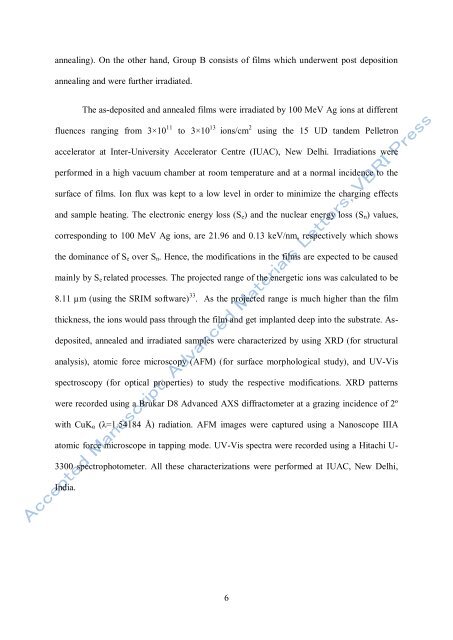Modification of nanocrystalline rf sputtered tin oxide thin film using ...
Modification of nanocrystalline rf sputtered tin oxide thin film using ...
Modification of nanocrystalline rf sputtered tin oxide thin film using ...
You also want an ePaper? Increase the reach of your titles
YUMPU automatically turns print PDFs into web optimized ePapers that Google loves.
annealing). On the other hand, Group B consists <strong>of</strong> <strong>film</strong>s which underwent post deposition<br />
annealing and were further irradiated.<br />
The as-deposited and annealed <strong>film</strong>s were irradiated by 100 MeV Ag ions at different<br />
fluences ranging from 3×10 11 to 3×10 13 ions/cm 2 <strong>using</strong> the 15 UD tandem Pelletron<br />
accelerator at Inter-University Accelerator Centre (IUAC), New Delhi. Irradiations were<br />
pe<strong>rf</strong>ormed in a high vacuum chamber at room temperature and at a normal incidence to the<br />
su<strong>rf</strong>ace <strong>of</strong> <strong>film</strong>s. Ion flux was kept to a low level in order to minimize the charging effects<br />
and sample hea<strong>tin</strong>g. The electronic energy loss (Se) and the nuclear energy loss (Sn) values,<br />
corresponding to 100 MeV Ag ions, are 21.96 and 0.13 keV/nm, respectively which shows<br />
the dominance <strong>of</strong> Se over Sn. Hence, the modifications in the <strong>film</strong>s are expected to be caused<br />
mainly by Se related processes. The projected range <strong>of</strong> the energetic ions was calculated to be<br />
8.11 µm (<strong>using</strong> the SRIM s<strong>of</strong>tware) 33 . As the projected range is much higher than the <strong>film</strong><br />
thickness, the ions would pass through the <strong>film</strong> and get implanted deep into the substrate. As-<br />
deposited, annealed and irradiated samples were characterized by <strong>using</strong> XRD (for structural<br />
analysis), atomic force microscopy (AFM) (for su<strong>rf</strong>ace morphological study), and UV-Vis<br />
spectroscopy (for optical properties) to study the respective modifications. XRD patterns<br />
were recorded <strong>using</strong> a Brukar D8 Advanced AXS diffractometer at a grazing incidence <strong>of</strong> 2º<br />
with CuKα (λ=1.54184 Å) radiation. AFM images were captured <strong>using</strong> a Nanoscope IIIA<br />
atomic force microscope in tapping mode. UV-Vis spectra were recorded <strong>using</strong> a Hitachi U-<br />
3300 spectrophotometer. All these characterizations were pe<strong>rf</strong>ormed at IUAC, New Delhi,<br />
India.<br />
6
















